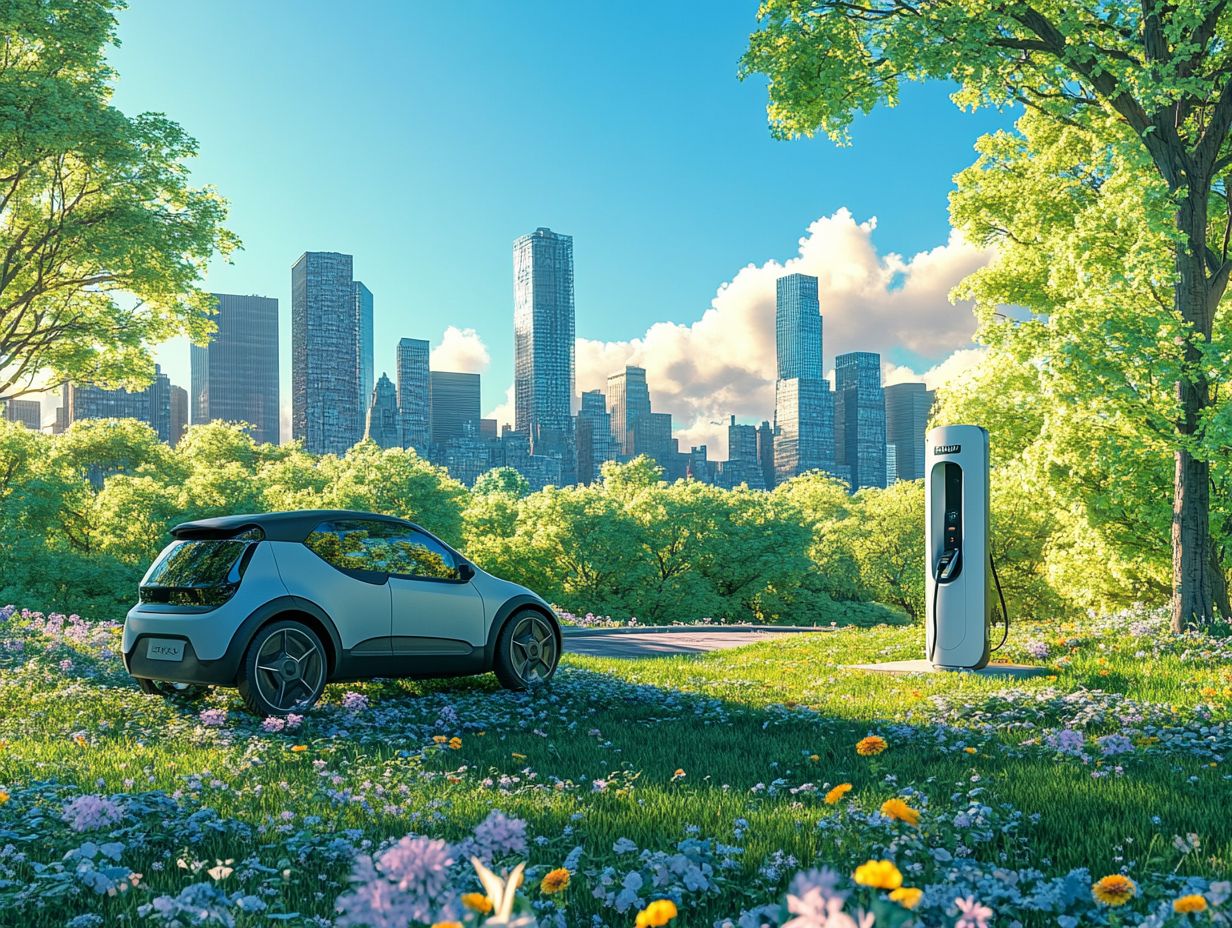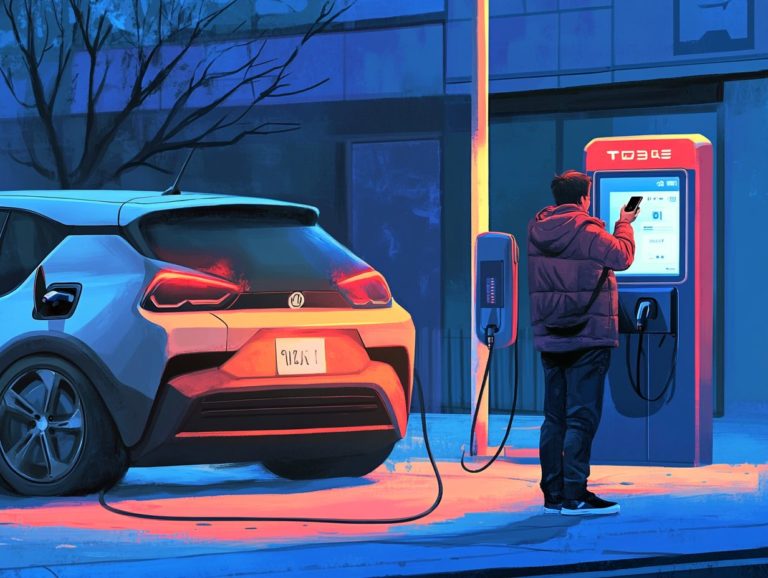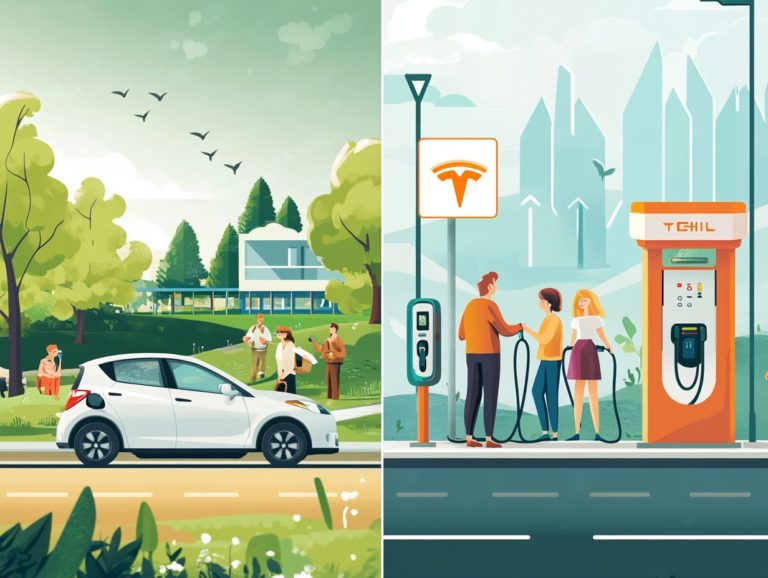how do electric vehicles reduce carbon footprint?
With climate change becoming a bigger concern, understanding your carbon footprint is essential.
This article explores how electric vehicles (EVs) can reduce pollution and transform our environment.
You ll learn about the different types of EVs, how they eliminate harmful emissions, and their role in minimizing pollution from energy production.
The discussion also covers environmental benefits, challenges, and future innovations within the EV industry. Join us as we uncover how electric vehicles can lead the charge towards a greener planet.
Contents
- Key Takeaways:
- Understanding the Carbon Footprint
- What are Electric Vehicles?
- How Electric Vehicles Reduce Carbon Footprint
- Benefits of Electric Vehicles for the Environment
- Challenges and Limitations of Electric Vehicles
- Future of Electric Vehicles and Carbon Footprint Reduction
- Frequently Asked Questions
- How do electric vehicles reduce carbon footprint?
- Do electric vehicles emit any carbon emissions?
- What is the environmental impact of using electric vehicles?
- How do electric vehicles contribute to a greener future?
- Are there any other benefits to using electric vehicles?
- How can I reduce my carbon footprint with an electric vehicle?
Key Takeaways:

Electric vehicles reduce pollution by eliminating tailpipe emissions and minimizing energy production waste. They also benefit the environment by decreasing air pollution and conserving natural resources. Despite some challenges, the future looks bright with ongoing innovations in the industry.
Understanding the Carbon Footprint
Your carbon footprint is crucial in tackling climate change and reducing greenhouse gas emissions, especially from transportation, a major source of pollution.
To achieve cleaner air and a sustainable future, assessing the contributions of various sectors and technologies is vital in minimizing your overall carbon footprint.
This evaluation helps transition to a more environmentally friendly energy landscape that benefits everyone.
Definition and Importance
The carbon footprint represents the total greenhouse gas emissions like carbon dioxide and methane linked to human activities.
This measurement reveals how your choices, industrial processes, and transportation methods connect to climate change. By quantifying emissions, you can identify areas for improvement and adopt more sustainable practices.
Various tools and methods are available for calculating your carbon footprint, from simple online calculators to detailed corporate assessments. Understanding this concept shapes policies and behaviors that help protect our environment, creating a sustainable future for generations to come.
What are Electric Vehicles?
Electric vehicles (EVs) are revolutionizing the automotive industry by using electric power instead of traditional fossil fuels.
This shift is a monumental change in transportation, steering it towards electrification and sustainability.
By significantly reducing greenhouse gas emissions and pollution, electric vehicles are not just a passing trend; they are critical in fighting climate change and advancing clean energy solutions.
Types of Electric Vehicles
You can find several types of electric vehicles today, including battery electric vehicles (BEVs), hybrid electric vehicles (HEVs), and plug-in hybrid electric vehicles (PHEVs). Each uses different technologies to reduce pollution.
For example, battery electric vehicles operate solely on electricity and produce zero tailpipe emissions, making them essential allies in the battle against climate change.
Hybrid electric vehicles combine a traditional internal combustion engine with an electric propulsion system, improving fuel efficiency and cutting harmful emissions.
Plug-in hybrids offer the convenience of driving in electric mode for shorter trips while allowing you to switch to gas for longer journeys.
As awareness grows, adopting these vehicles plays a significant role in reducing overall pollution and paving the way for a cleaner, electrified future.
How Electric Vehicles Reduce Carbon Footprint

Electric vehicles significantly lower your carbon footprint by tackling emissions in two key ways: they reduce emissions from energy production and completely eliminate tailpipe emissions. This makes them essential for sustainable transportation.
As you embrace the shift toward a more electrified transportation sector, you ll notice the positive effects on air quality and the overall reduction of pollution becoming increasingly apparent.
Reducing Emissions from Energy Production
Electric vehicles help reduce emissions from energy production by tapping into low-emission generation sources. This shift lowers greenhouse gas emissions compared to traditional fossil fuel vehicles.
By embracing renewable energy sources like solar and wind power, these vehicles play a crucial role in transforming the energy landscape. More electric vehicles on the road mean higher demand for clean energy, prompting energy producers to move away from coal and natural gas.
This transition not only curbs air pollution but also stimulates investment in groundbreaking technologies that improve battery storage and grid management.
As a result, the synergy between electric vehicles and renewable energy creates a sustainable ecosystem, setting the stage for a future where clean energy is the standard.
Eliminating Tailpipe Emissions
One of the standout advantages of electric vehicles is their ability to eliminate tailpipe emissions, which directly enhances air quality and reduces pollution levels in urban areas.
Switching to electric vehicles creates healthier living environments by significantly reducing harmful pollutants such as nitrogen oxides harmful gases that can cause respiratory problems and particulate matter. This transformation also plays a crucial role in fighting climate change.
As more drivers embrace electric alternatives, get ready for cleaner air and a noticeable drop in smog levels, benefiting public health. Ultimately, these improvements in air quality can lead to lower healthcare costs and a better quality of life for all residents.
Benefits of Electric Vehicles for the Environment
Electric vehicles offer a multitude of environmental advantages, including substantial reductions in pollution, enhanced air quality, and conservation of invaluable natural resources.
Embracing electric vehicles is crucial for our future and an essential step in the transition toward cleaner energy solutions.
Reducing Air Pollution
Electric vehicles are vital in the quest to reduce air pollution, effectively lowering harmful pollutants such as nitrogen oxides and particulate matter. This significant improvement in air quality is particularly evident in densely populated areas.
By eliminating tailpipe emissions, these eco-friendly alternatives reduce the presence of toxic substances linked to respiratory illnesses and other serious health issues. Cities that actively promote electric vehicle usage have seen remarkable improvements in air quality, creating a healthier environment for residents.
This transition not only supports public health but also leads to decreased healthcare costs associated with pollution-related conditions.
As electric vehicle adoption rates continue to rise, expect further reductions in smog and an overall improvement in community well-being. This compelling case for sustainable transportation solutions highlights the vital role that electric vehicles play in shaping a cleaner, healthier future.
Make the switch today for a healthier tomorrow!
Conserving Natural Resources

By transitioning to electric vehicles, you have the chance to conserve natural resources and reduce your reliance on fossil fuels while supporting renewable energy growth.
This shift lowers greenhouse gas emissions key contributors to climate change and encourages the use of wind, solar, and hydroelectric power.
As more individuals embrace electric vehicles, the demand for clean energy solutions increases, prompting governments and businesses to invest in sustainable infrastructure.
With advancements in technology, battery production is evolving, highlighting the need for ethically sourced materials.
Your choice positions you as an active participant in a larger movement toward a greener, more sustainable planet.
Challenges and Limitations of Electric Vehicles
Despite many advantages, electric vehicles still face challenges.
The need for improved infrastructure and concerns about affordability can hinder their broader acceptance in transportation.
Infrastructure and Affordability
Developing charging infrastructure and reducing costs are crucial for making electric vehicles more affordable and accessible.
Without a solid network of charging stations, you may hesitate to embrace electric vehicles due to fears of running out of battery before reaching a charger.
Addressing financial barriers is equally important, as high upfront costs can be off-putting. Investing in charging stations and utilizing government incentives can create a seamless ecosystem.
This initiative would pave the way for widespread adoption and foster a sustainable future, benefiting both society and the environment.
Future of Electric Vehicles and Carbon Footprint Reduction
The future of electric vehicles holds immense potential for innovation and growth in the industry.
By embracing this evolution, you play a crucial role in significantly reducing carbon footprints and advancing clean energy solutions.
Innovations and Growth in the Industry
The electric vehicle industry is seeing remarkable growth and technological innovations that boost performance and overall consumer acceptance.
As manufacturers invest in advanced battery technologies and sophisticated charging infrastructure, you’ll notice extended vehicle range and dramatically reduced charging times.
Innovations like solid-state batteries a new type of battery that offers better energy storage and wireless charging are set to enhance your experience.
Many companies are integrating eco-friendly materials into their vehicle designs, increasing their market appeal.
These advancements are driving the sector toward unprecedented growth, reshaping the automotive landscape for years to come.
Frequently Asked Questions

How do electric vehicles reduce carbon footprint?
Electric vehicles reduce carbon footprint by using electricity instead of gasoline or diesel, producing significantly less carbon emissions. To learn more about their operation, check out how electric vehicles work.
Do electric vehicles emit any carbon emissions?
Electric vehicles emit much less carbon than traditional vehicles, mainly from power plants instead of tailpipes.
What is the environmental impact of using electric vehicles?
Using electric vehicles significantly reduces air pollution and greenhouse gas emissions, leading to improved air quality and less contribution to climate change.
How do electric vehicles contribute to a greener future?
Electric vehicles help create a greener future. They reduce the demand for fossil fuels and cut down carbon emissions, which helps fight climate change.
Are there any other benefits to using electric vehicles?
Absolutely! Electric vehicles lower your carbon emissions and offer reduced costs for fuel and upkeep.
They also need less maintenance and can be powered by renewable energy, making them a smart choice.
How can I reduce my carbon footprint with an electric vehicle?
You can lower your carbon impact by using public charging stations and powering your vehicle with renewable energy.
Drive efficiently to maximize your battery range, and remember to dispose of your vehicle’s batteries properly.






